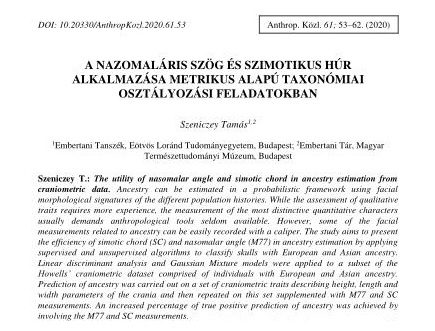A nazomaláris szög és szimotikus húr alkalmazása metrikus alapú taxonómiai osztályozási feladatokban
Absztrakt
Ancestry can be estimated in a probabilistic framework using facial morphological signatures of the different population histories. While the assessment of qualitative traits requires more experience, the measurement of the most distinctive quantitative characters usually demands anthropological tools seldom available. However, some of the facial measurements related to ancestry can be easily recorded with a caliper. The study aims to present the efficiency of simotic chord (SC) and nasomalar angle (M77) in ancestry estimation by applying supervised and unsupervised algorithms to classify skulls with European and Asian ancestry. Linear discriminant analysis and Gaussian Mixture models were applied to a subset of the Howells’ craniometric dataset comprised of individuals with European and Asian ancestry. Prediction of ancestry was carried out on a set of craniometric traits describing height, length and width parameters of the crania and then repeated on this set supplemented with M77 and SC measurements. An increased percentage of true positive prediction of ancestry was achieved by involving the M77 and SC measurements.
Hivatkozások
Falconer, D.S. (1989): Introduction to Quantitative Genetics. 3rd ed. John Wiley & Sons, New York.
Farkas, Gy. (1972): Antropológiai praktikum I-II. JATE, Szeged.
Fóthi, E. (2014): A Kárpát-medence 6–11. századi történetének embertani vonatkozásai. In: Sudár, B., Szentpéteri, J., Petkes, Zs., Lezsák, G., Zsidai, Z. (Szerk.) Magyar őstörténet. Tudomány és hagyományőrzés. MTA Bölcsészettudományi Kutatóközpont, Budapest. pp. 151–168.
González‐José, R., Van der Molen, S., González‐Pérez, E., Hernandez, M. (2004): Patterns of phenotypic covariation and correlation in modern humans as viewed from morphological integration. Am. J. Phys. Anthropol., 123(1): 69–77. DOI: 10.1002/ajpa.10302.
Hanihara, T. (2000). Frontal and facial flatness of major human populations. Am. J. Phys. Anthropol., 111(1): 105–134. DOI: 10.1002/(SICI)1096-8644(200001)111:1<105::AID-AJPA7>3.0.CO;2-O
Harvati, K., Weaver, T.D. (2006): Human cranial anatomy and the differential preservation of population history and climate signatures. Anat. Rec. A Discov. Mol. Cell. Evol. Biol., 288(12): 1225–1233. DOI: 10.1002/ar.a.20395
Howells, W.W. (1973): Cranial variation in man: A study by multivariate analysis of patterns of differece among recent human populations. Pap. Peabody Museum, 67: 1–259.
Howells, W.W. (1989): Skull shapes and the map: Craniometric Analyses in the Dispersion of Modern Homo. Pap. Peabody Museum, 78: 1-189.
Howells, W.W. (1995): Who’s Who in Skulls. Ethnic Identification of Crania from Measurements. Pap. Peabody Museum, 82: 1–108.
Lewontin, R.C. (1972): The Apportionment of Human Diversity. Evol. Biol., 6: 381–398.
Lipták, P. (1965): On the taxonomic method in Paleoantropology (historical anthropology). Acta Biol. Szeged., (11): 169–183.
Lipták, P. (1980): Embertan és emberszármazástan. Tankönyvkiadó Vállalat, Budapest.
Mardia, K.V. (1970): Measures of multivariate skewness and kurtosis with applications. Biometrika, 57(3): 519–530.
Martínez‐Abadías, N., Esparza, M., Sjøvold, T., Gonzalez-José, R., Santos, M., Hernándet, M. (2009): Heritability of human cranial dimensions: comparing the evolvability of different cranial regions. J. Anat., 214(1): 19–35. DOI: 10.1111/j.1469-7580.2008.01015.x
Rogers, A.R., Harpending, H.C. (1983): Population structure and quantitative characters. Genetics, 105: 985–1002.
Roseman, C.C., Weaver, T.D. (2007). Molecules versus morphology? Not for the human cranium. Bioessays, 29(12): 1185–1188. DOI: 10.1002/bies.20678
Scrucca, L., Fop, M., Murphy, T.B., Raftery, A.E. (2016). mclust 5: clustering, classification and density estimation using Gaussian finite mixture models. R. J., 8(1): 289–317.
Smith, H.F. (2009): Which cranial regions reflect molecular distances reliably in humans? Evidence from threedimensional morphology. Am. J. Hum. Biol., 21: 36–47. DOI: 10.1002/ajhb.20805
Thoma, A. (2002): Europid és mongolid koponyák megkülönböztetése. Anthrop. Közl., 43: 27–28.
Ubelaker, D.H., Buikstra, J.E. (1994): Standards for data collection from human skeletal remains. Ark. Archaeol. Sur. Res., 44: 206–212.
Venables, W.N., Ripley, B.D. (2002): Modern Applied Statistics with S. 4th ed. Springer, New York.
von Cramon-Taubadel, N. (2014): Evolutionary insights into global patterns of human cranial diversity: population history, climatic and dietary effects. J. Anthropol. Sci., 92(4): 43–77. DOI: 10.4436/jass.91010
von Cramon‐Taubadel, N., Weaver, T.D. (2009): Insights from a quantitative genetic approach to human morphological evolution. Evol. Anthropol., 18(6): 237–240. DOI: 10.1002/EVAN.20233




